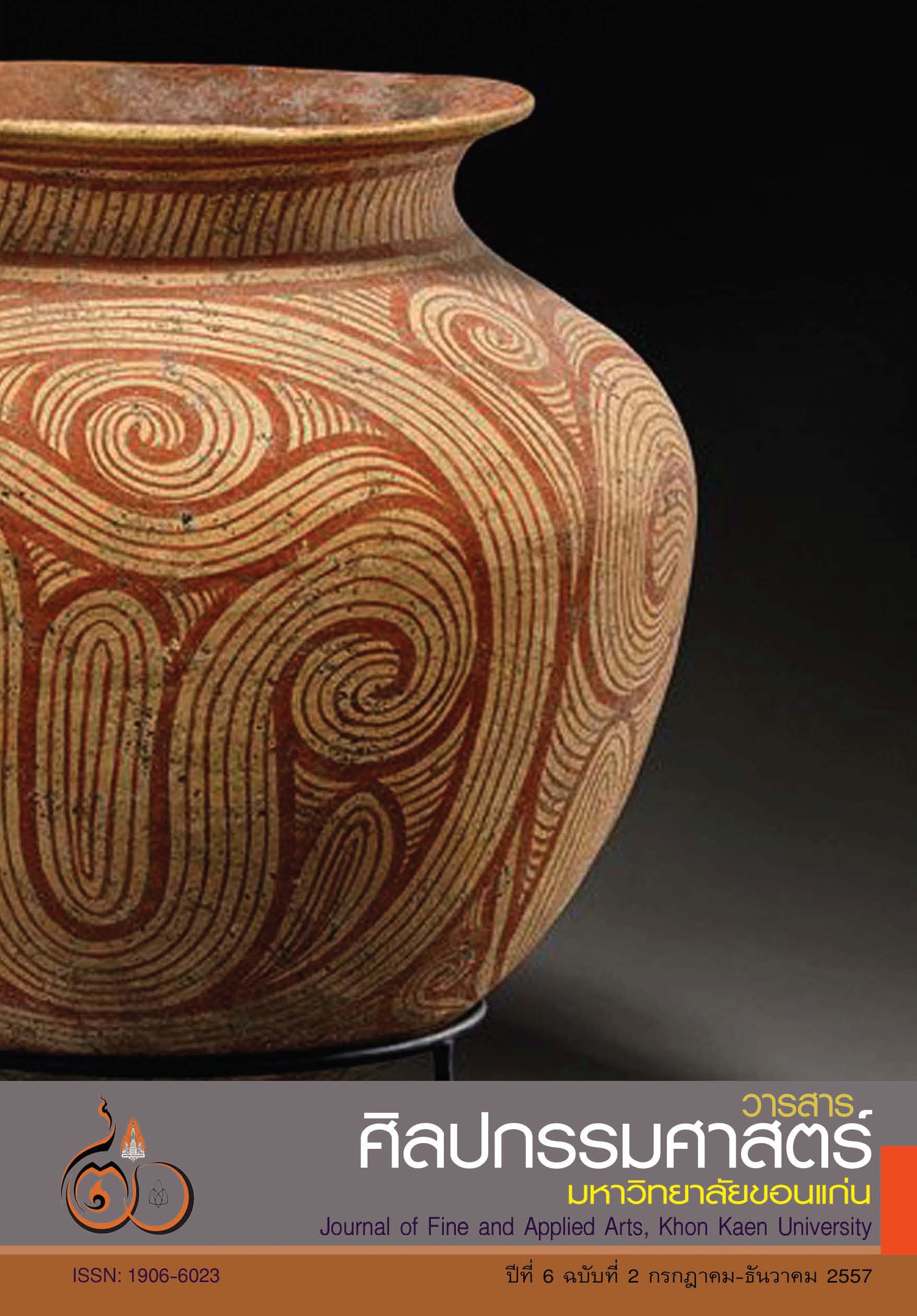ลวดลายประทับดินเผาบ้านเชียง : บูรณาการสู่การออกแบบผลิตภัณฑ์เชิงพาณิชย์ Ban Chiang pottery pattern stamp : Integrated into design of commercial products
Main Article Content
Abstract
การวิจัยลวดลายประทับดินเผาบ้านเชียง : บูรณาการสู่การออกแบบผลิตภัณฑ์เชิงพาณิชย์มีวัตถุประสงค์ 1) ศึกษาและรวบรวมลวดลายประทับ กรณีศึกษาลวดลายลูกกลิ้งและตราประทับดินเผา บ้านเชียง 2) วิเคราะห์ลวดลายประทับดินเผาบ้านเชียงเพื่อประยุกต์เป็นแนวคิดในการออกแบบผลิตภัณฑ์ 3) สังเคราะห์ลวดลายประทับดินเผาบ้านเชียงให้เหมาะสมสอดคล้องกับการออกแบบผลิตภัณฑ์เชิงพาณิชย์
กลุ่มตัวอย่างได้แก่ ลูกกลิ้งและตราประทับดินเผาบ้านเชียงใช้แบบสำรวจพิพิธภัณฑสถานแห่งชาติที่จัดแสดงโบราณวัตถุบ้านเชียง 12 แห่ง เพื่อรวบรวมข้อมูลใช้ประกอบการวิเคราะห์ลวดลาย เจ้าหน้าที่และบุคลากรพิพิธภัณฑสถานแห่งชาติบ้านเชียงใช้แบบสัมภาษณ์ถึงข้อมูลตราประทับดินเผาบ้านเชียง ผู้ผลิตและกลุ่มร้านค้าผลิตภัณฑ์ชุมชนบ้านเชียง จังหวัดอุดรธานีจำนวน 35 ร้านค้า ใช้แบบสัมภาษณ์เพื่อให้ได้ข้อมูลความต้องการรูปแบบผลิตภัณฑ์ใหม่ ผู้ทรงคุณวุฒิด้านการออกแบบและปราชญ์ชาวบ้าน ใช้แบบประเมินคู่มือ และแบบร่างผลิตภัณฑ์ที่นำลวดลายประทับดินเผาบ้านเชียงมาใช้ในการออกแบบค
ผลการวิจัยพบว่า พิพิธภัณฑสถานแห่งชาติที่จัดแสดงโบราณวัตถุลูกกลิ้งและตราประทับดินเผาบ้านเชียงมีเพียง 4 แห่ง ได้แก่ที่ เชียงใหม่, กรุงเทพฯ, ขอนแก่น และอุดรธานี มีปริมาณรวมทั้งสิ้น 232 ชิ้น เมื่อเปรียบเทียบกับตราประทับดินเผาอื่นในประเทศไทยและต่างประเทศ ปรากฏว่า ตราประทับดินเผาบ้านเชียงมีความลึก ลวดลายที่คมชัด มีความประณีตในการสร้างลวดลายมากกว่าที่อื่น ในการจัดหมวดหมู่ลายผู้วิจัยคำนึงถึงความสอดคล้องกับลายเครื่องปั้นดินเผาบ้านเชียงและหลักการออกแบบลวดลายสรุปได้ 3 หมวดหมู่ คือ 1) ลายเส้น 2) ลายเรขาคณิต 3) ลายธรรมชาติ และนำลวดลายไปต่อยอดกับภูมิปัญญาในการพัฒนาผลิตภัณฑ์เชิงพาณิชย์ของชุมชนบ้านเชียง จังหวัดอุดรธานี ลวดลายที่ได้รับความสนใจมากที่สุด คือ ลายธรรมชาติ การสร้างคู่มือองค์ความรู้ลวดลายประทับบ้านเชียงควรจัดหมวดหมู่ลายให้สอดคล้องกับลวดลายเครื่องปั้นดินเผาบ้านเชียง เพื่อให้ง่ายในการเรียนรู้ รูปภาพประกอบต้องชัดเจน เข้าใจง่าย และมีการจัดแบ่งแนวทางการออกแบบสู่ผลิตภัณฑ์ต่างๆ ในการนำมาพัฒนาผลิตภัณฑ์ 3 รูปแบบ คือ 1) เครื่องปั้นดินเผา จำลองตราประทับดินเผาสำหรับตั้งโชว์มากที่สุด 2) ผลิตภัณฑ์สิ่งทอ มีค่าความต้องการที่สอดคล้องกันในการผลิตผ้าผืนเทคนิคการทอ การพิมพ์ลายและผ้าบาติก แปรรูปเป็นผ้าแต่ง เช่น ตีนซิ่น และสกรีนลายหรือเพ้นท์บนเสื้อยืด 3) ผลิตภัณฑ์เครื่องจักสาน ผลิตของใช้ เช่น หมวก กระเป๋ามากที่สุด
The objectives of this research are 1) Studying and collecting pattern stamped A case study of the Ban Chiang pattern roller and clay seal. 2) To analyze patterns Ban Chiang pottery pattern stamp to applied is the concept in product design. 3) Synthetic Ban Chiang pottery pattern stamp to suitable commercial product design.
The samples used in this research are rollers and stamps for pottery in Bang Chiang. The survey method is employed on 12 National Museums that exhibit Ban Chiang pottery, whereas, the data is obtained from pottery patterns analysis. Ban Chiang National Museum staff and personnel are interviewed on Ban Chiang pottery stamp patterns information. Thirty-five pottery manufacturers and stores in Ban Chiang, Udon Thani are also interviewed for information needed in new product requirement. Expert in designing as well as local scholars employ evaluation form as well as sketch design from Ban Chiang pottery source in guiding new design.
The results show that the there are only 4 National Museums that exhibit Bang Chiang pottery rollers and stamps; those museums are located in Chiang Mai, Bangkok, Khon Kaen, and Udon Thani with total number of rollers and stamps of 232 pieces. In comparison with other pottering stampings in Thailand and other countries, it is found that Ban Chiang pottery stampings are more distinctive with its depth, sharp patterning, as well as sophistication in patterns creation, than other places. In pattern classification, the researcher takes into account the consistency of pottery pattern in Ban Chiang source as well as principles of pattern designs which can be categorized in 3 types; 1) stripes, 2) geometries, and 3) natures. These patterns would extend the wisdom for developing commercial products of the Community of Ban Chiang, Udon Thani. The pattern that receives much attention is the pattern of nature. The guide for learning Ban Chiang stamped patterns should be classified and be consistent with Ban Chiang genuine pottery designs. This makes learning easier. Pictures in the guide should be clearly depicted, understandable, as well as providing 3 separate design guidelines for developing products, which are 1). Pottery - pottery stampings modeling as most exhibited; 2). Textiles – a kind of valuable, corresponding, and consistent with textile weaving techniques, as well as textile printing and batik which can be processed into decorated textiles, e.g. Sarong Foot (Teen-Sin) and patterns screening or T-shirt painting; and 3). Wickers – appliance production, e.g. pockets and hats.
Article Details
Content and information in articles published in the Journal of Fine and Applied Arts of Khon Kaen University is regarded as the opinion and sole responsibility of the author(s) directly; therefore, editors are not obliged to agree to or share any responsibility with regard to the content and information that appears within these articles.
All articles, information, content, image, etc. that have been published in the Journal of Fine and Applied Arts of Khon Kaen University is the copyright of the Journal of Fine and Appllied Arts of Khon Kaen University. Any person or organization who wishes to distribute all or parts of the articles for further dissemination or other usage must first receive permission from the Journal of Fine and Applied Arts of Khon Kaen University before proceeding to do so.


